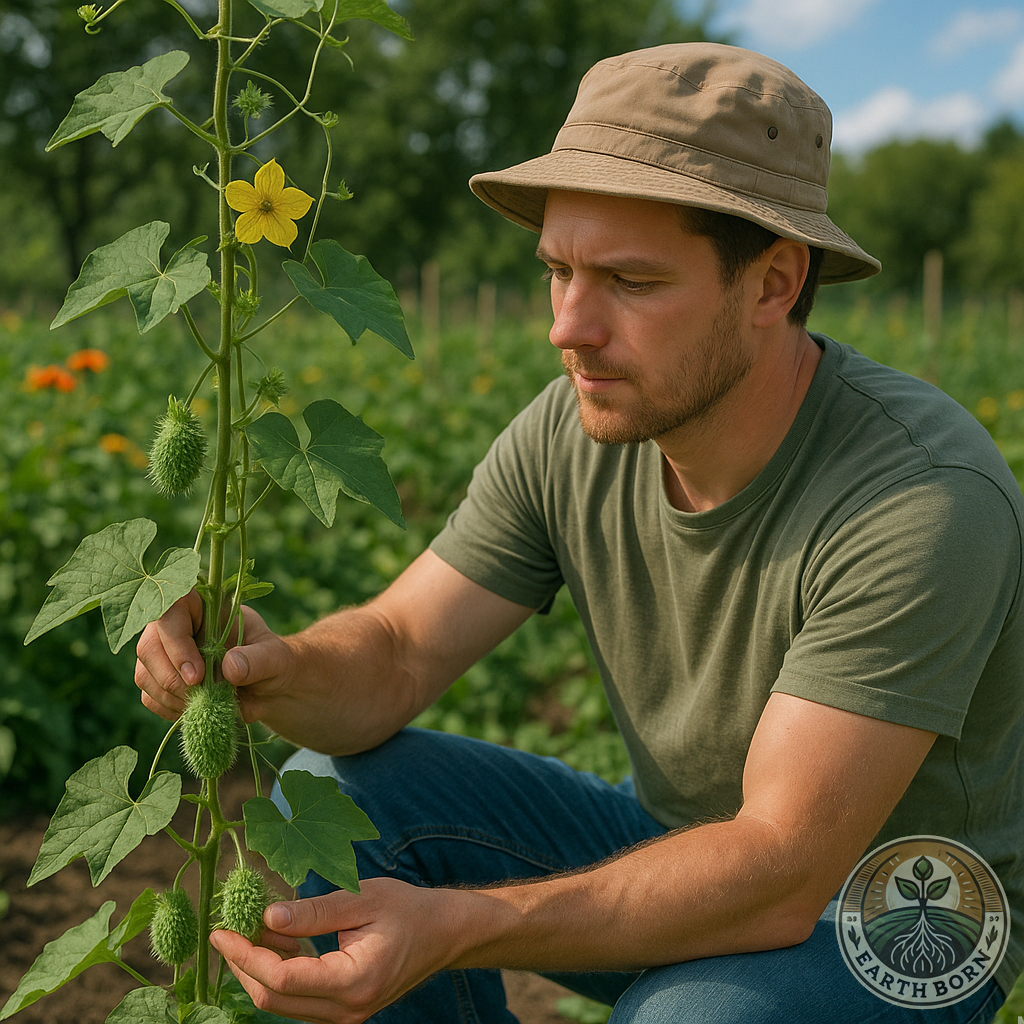
🌱 Introduction and history
Bushu (Cucumis zambianus), also known as the African Wild Cucumber or Zambian Cucumber, is an annual climbing plant in the Cucurbitaceae family — relatives of gourds, melons, and cultivated cucumbers. Indigenous to Southern Africa, it grows naturally in South Africa, Zambia, and Zimbabwe, thriving in grasslands and along fences. Traditionally gathered from the wild, Bushu has been valued not only for its unique spiky green fruits but also for its medicinal and cultural uses.
💊 Medicinal Benefits
In traditional African medicine, Bushu has been used for:
- Digestive support – Leaf infusions may relieve indigestion and mild stomach discomfort.
- Anti-inflammatory properties – Compounds such as cucurbitacins are believed to reduce inflammation.
- Mild detoxification – Sometimes used in small amounts as a gentle cleansing herb.
⚠️ Note: Overconsumption can cause nausea or stomach upset. Always use in moderation.
📅 When to Plant in South Africa
Plant Bushu seeds in spring after the last frost, ideally from September to November. In warmer coastal areas, sowing can be extended to early summer. Seeds germinate in 7–14 days, and plants mature for harvest in 60–90 days.
🏡 Where to Plant
Bushu prefers open ground where it can sprawl or climb on supports like trellises or fences. Ideal for vegetable gardens, sunny borders, or edges of cultivated fields.
🌞 Soil, Water & Sunlight Requirements
✅ Soil – Well-draining, fertile soil enriched with compost or aged manure.
✅ Sunlight – Full sun (6–8 hours daily) for best flowering and fruiting.
✅ Water – Keep soil evenly moist; avoid waterlogging to prevent root rot.
✅ Fertilize – Apply a balanced organic fertilizer monthly during active growth.
✅ Spacing – 30–45 cm apart for bush growth; 60 cm if trellising.
✅ Seeds germinate – 7–14 days in warm soil.
✅ Transplanting – Move seedlings after 2–3 weeks when they have at least 2–3 true leaves.
✅ Maturity height – Vines can trail 1–2 m; with support, they can climb higher.
🍓 Flowers & Fruit
Bushu produces small yellow flowers, followed by oval, green, spiny fruits resembling miniature cucumbers. The fruit turns yellow when ripe.
🌼 Companion Plants
Good companions:
- Tomatoes – Improve pollination and reduce pests.
- Basil – Repels insects.
- Marigolds – Deter nematodes and aphids.
🐛 Common Pests
Watch for:
- Aphids
- Spider mites
- Whiteflies
Use natural deterrents like neem oil sprays or soapy water.
🧺 Harvesting
Harvest fruits when green and tender for culinary use, or when yellow for seed saving. Leaves for medicinal tea can be picked fresh as needed.
🫙 Storage
- Fruits – Store fresh in a cool, dry place for up to 1 week.
- Leaves – Use fresh or dry in a shaded, well-ventilated area. Store dried leaves in airtight jars away from sunlight.
🧪 How to Use as Medicine
Digestive Tea
- 1 tsp dried leaves in 1 cup hot water.
- Steep for 5–10 minutes, strain, and drink warm.
- Limit to 1 cup per day for no more than 5 days.
🎉 Fun Fact
The spiny fruit of Bushu deters many pests naturally — making it a built-in protector for some garden crops.
⚠️ Caution
- Do not consume large quantities — may cause nausea.
- Pregnant or breastfeeding women should avoid medicinal use unless advised by a healthcare professional.
- Not recommended for children under 12 without professional guidance.
📣 Call to Action
Why not add a touch of African heritage to your garden? 🌱 Plant Bushu this spring and enjoy its rapid growth, beautiful blooms, and traditional benefits. Share your Bushu growing journey with us!
#EarthBornGrower #GrowBushu #AfricanWildCucumber #MedicinalPlants #SouthAfricanGardening


 **Meet Sprout!** Sprout is your friendly gardening companion at Earthborn, always ready with helpful advice on plant care, medicinal herbs, and natural gardening solutions. From seedling to harvest, Sprout provides expert guidance to nurture your garden and your well-being—making gardening easy, fun, and naturally rewarding.
**Meet Sprout!** Sprout is your friendly gardening companion at Earthborn, always ready with helpful advice on plant care, medicinal herbs, and natural gardening solutions. From seedling to harvest, Sprout provides expert guidance to nurture your garden and your well-being—making gardening easy, fun, and naturally rewarding.
